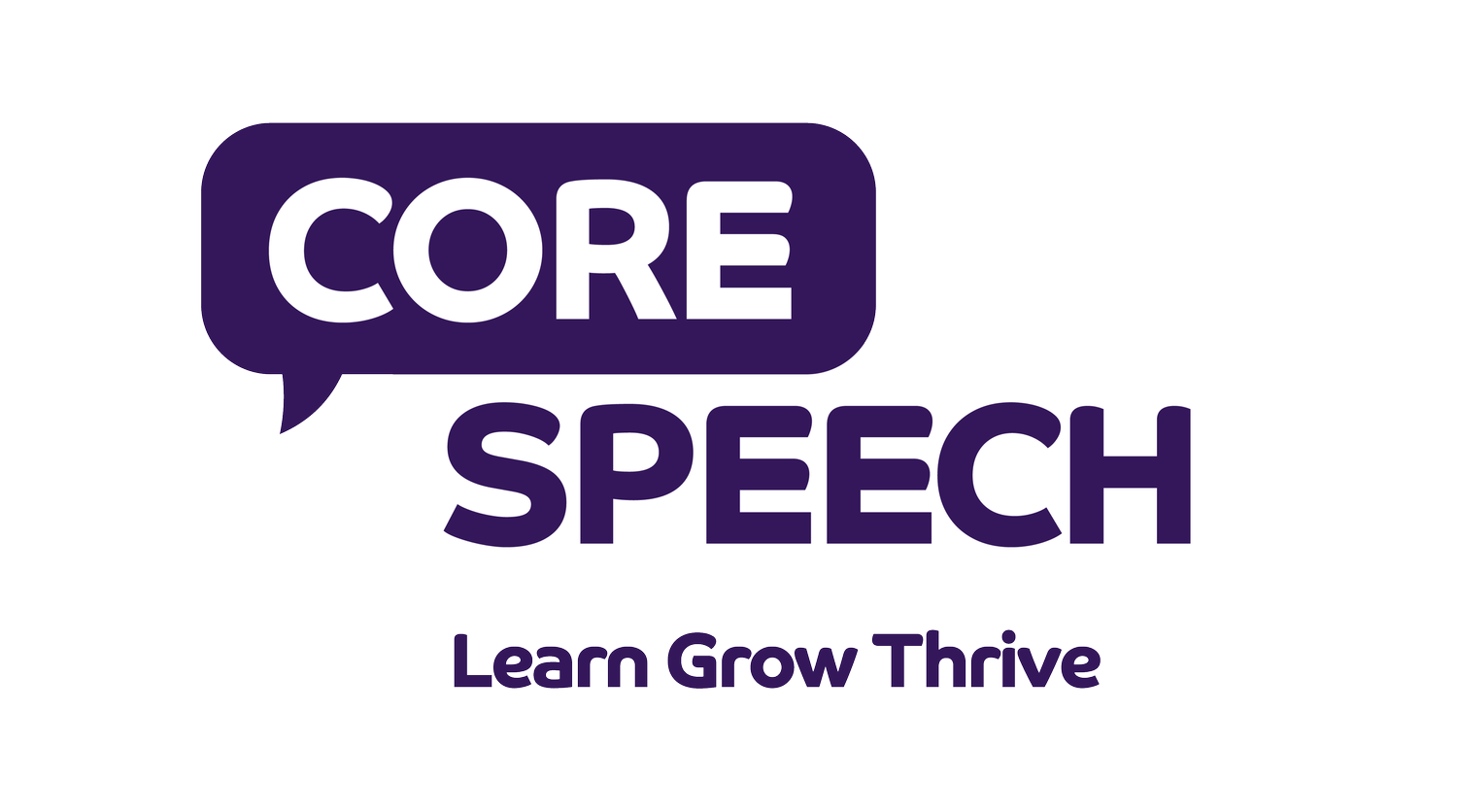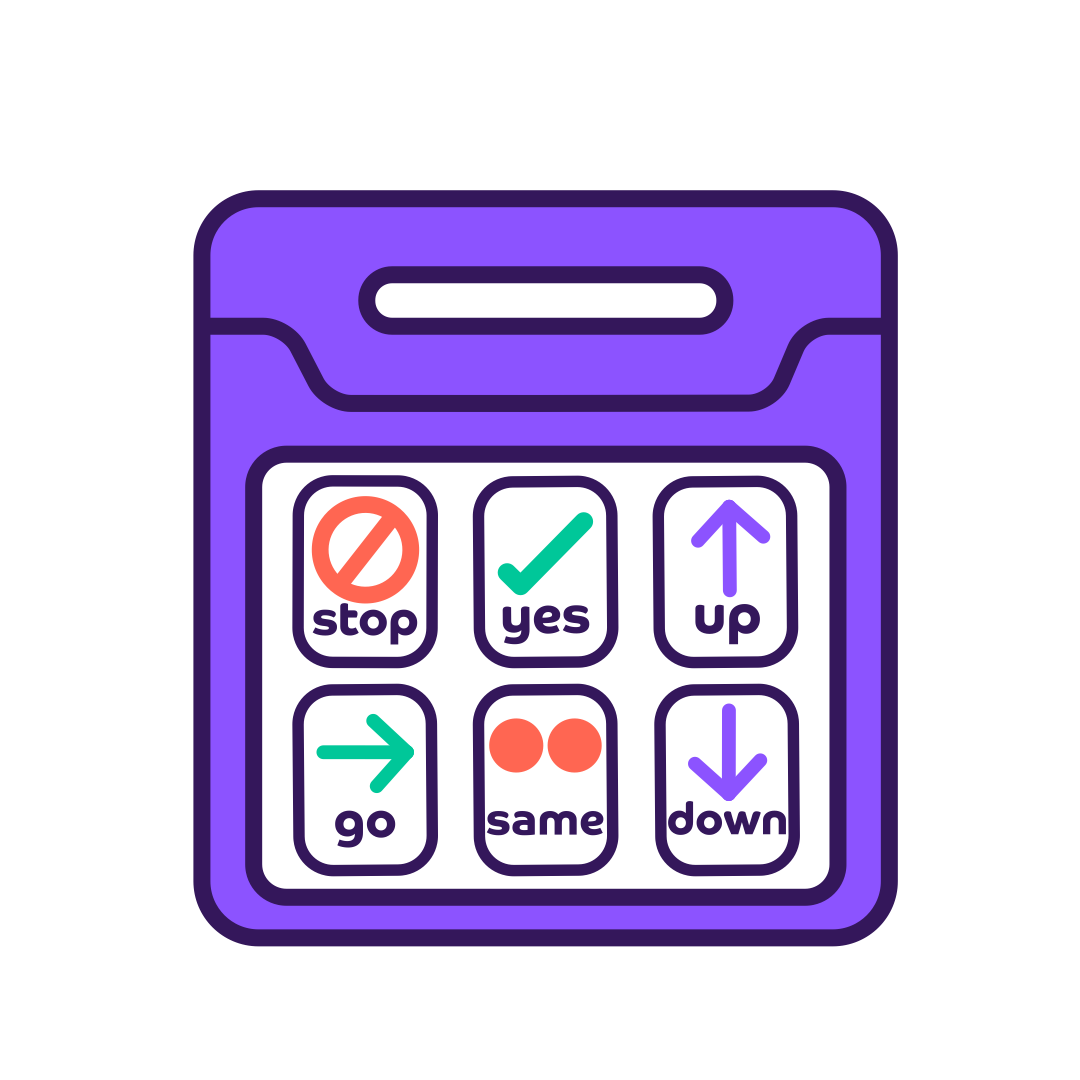Augmentative and Alternative Communication (AAC)
Augmentative and Alternative Communication (AAC) are a range of strategies and tools that help individuals who are unable to use verbal speech successfully communicate with others.
AAC is an umbrella term used to describe a range of different methods that a person uses to communicate additional to or in replacement of verbal speech. This includes both unaided methods (e.g., signing, gestures, facial expressions, body language) and aided methods (e.g., Aided Language Display Boards, Communication books, Electronic Communication Devices).
Using AAC supports individual to successfully communicate and provides them with a consistent method to express their wants, needs, thoughts, and ideas to others. This enables them to experience the power of being understood and continue the circle of communication.
Emma is experienced in using a wide range of different AAC tools and can assist you in determining the most appropriate system for your child by taking into consideration their current strengths and abilities in order to identify suitable access methods and language systems.
Core Speech can also provide ongoing training and therapy sessions to help your child implement use of their AAC to their fullest potential and ensure they Learn, Grow and Thrive.
Core Speech has access to a wide range of communication applications and tools which can clients can try during their assessment and therapy sessions. We also have a range of Aided Language Display Boards available to download today.
“For people without disabilities, technology makes things easier. For people with disabilities, technology makes things possible.”
IBM
Core Speech can provide AAC support in the following areas:
Implementing signing systems such as Makaton signing.
Developing customised communication books including Pragmatic Organisation Dynamic Display (PODD).
Supporting use of power-based devices with specially designed communication apps (e.g., TD Snap, Super Core).
Exploring alternative access methods for individuals with physical differences including switches and eye gaze.
“The goal of AAC is autonomous communication. That is being able to to say what I want to say, to whoever I want to say it to, whenever I want to say it, and however I choose to say it.”
Gayle Porter, Developer of PODD
8 Signs your child may benefit from access to AAC:
1. Limited or no spoken language.
This may be related to specific diagnosis including autism, Down syndrome, or Cerebral Palsy.
2. Speech is highly unintelligible.
This may be related to specific diagnosis including Speech Sound Disorders and Childhood Apraxia of Speech (CAS).
3. Frustration
AAC can help to reduce frustration and behaviours resulting from communication breakdowns.
4. Speech is unreliable
AAC can help when speech is unreliable due to fluctuations in health, fatigue, and regulation.
5. Expressive Language Delays
AAC can support with expression when there is a discrepancy between understanding and expressive abilities.
6. Physical limitations
AAC can enable individuals with physical differences to communicate through alternative access methods (e.g., switches).
7. Community Access
AAC can support communication with unfamiliar people who are less familiar with the individuals’s communication style.
8. Access to the Curriculum
AAC can support individual’s to access the school curriculum and demonstrate their knowledge and abilities.
All of the above signs indicate that a child may benefit from use of AAC to support their functional communication skills and participation.
For more information regarding how Core Speech can support your child, please contact us.
“AAC is not a last resort. It is a first step to giving someone a voice.”
Janice Light, AAC Researcher and Professor
Common Questions about AAC
-
No - this is a common myth. Research shows that AAC does not hinder speech development; in fact, it encourages it. Providing a child with access to a reliable way to communicate can help to reduce frustration and support their language development.
-
An individualised assessment is essential in order to identify the most appropriate AAC system to introduce. A Speech and Language Therapy assessment will consider the user’s physical, cognitive, sensory, and communication needs in order to find a system that is accessible, functional, and motivating for the individual to use.
-
No - It is not necessary to start with paper-based AAC before morning to high-tech systems. The choice between paper-based or high-tech AAC should be based on the user’s needs, preferences, and access abilities - not a fixed sequence.
Some children benefit from starting with a high-tech device straight away, especially as they offer features such as voice output, recorded audio, and use of video or media to communicate. These features can be especially important for children who identify as Gestalt Language Processors and develop language as ‘units’ which they attribute meaning to based on their own experiences and emotions.
Other children may find paper-based tools more suitable, either in isolation or alongside high-tech devices.
It is not uncommon for both paper-based and high-tech devices to be used simultaneously as they have different features. Paper-based systems can be notably useful in environments which could pose risk or damage to high-tech devices, such as when swimming, at the beach, or playing outside in rain and snow.
-
No - AAC can be introduced at any age, even with very young children. Early access to communication tools can support learning and development of skills needed to access and use the tool.
-
No - there are no strict prerequisites for AAC. Some common myths that have been wrongfully circulated are they children need to be able to match pictures, point to pictures, or demonstrate their understanding of a picture before being introduced to AAC. These myths are not true. AAC can be used to teach and support communication even if the user has limited skills to begin with.
-
No - AAC systems can be adapted for many physical needs. If an individual has a physical difference that is impacting their ability to use their hands to touch or point to the AAC system, alternative access methods such as eye gaze, switch buttons, or partner assisted scanning can be used. If your child does not have any physical needs but is not yet pointing to communicate, AAC should still be introduced with a focus on modelling use of the system for communication.
-
Yes - many behaviours originate from frustration due to unmet communication needs. Providing access to AAC can often help to reduce the frequency or severity of those behaviours due to giving the individual a more appropriate and effective way to express themselves.
-
No - Many AAC systems use symbols, pictures, or photos which do not require reading. Children learn what these symbols mean by repeated exposure to them during meaningful activities. This helps them to build an association between the symbol and the real-life consequence.
For users who have already developed some literacy abilities, text-based systems can also be used.
There is a wide variety of AAC systems available and many are flexible enabling them to evolve as the user’s skills develop.
-
Yes - AAC can and should be used across all environments that your child experiences - home, visiting family, community groups, and school. Consistent use of AAC in daily life helps to build communication skills and supports communication partners to be confident at modelling language to further language development.
The Equality Act (2010) states that schools have a legal duty to make reasonable adjustments for pupils to ensure that they can fully participate in education and enjoy other benefits, facilities, and services which schools provide. If an AAC device is necessary for the child to communicate or access the curriculum, then this is a reasonable adjustment.
The SEND Code of Practice (2015) is statutory guidance which states that schools are required to identify and address the Special Educational Needs (SEN) of the pupils that they support. If an AAC device has been recommended by a professional supporting that pupil (e.g., Speech and Language Therapist) and is part of a reasonable plan to meet the child’s needs, the school should support it as part of its SEND duties.
The school’s Special Educational Needs and Disability Coordinator (SENDCO) will be able to provide further information about any potential challenges or barriers regarding the use of AAC in the school setting.
-
AAC can be funded in a few different ways in the UK depending on the type of system needed and the individual’s circumstances.
In England, high-tech communication devices (e.g., voice output devices, iPads with specialist software, eye gaze systems) can be funded through NHS England via Specialist AAC Hubs. These services assess individuals who meet NHS criteria and, if appropriate, fund communication devices along with training and support.
The ACE Centre, based in Oldham, is commissioned by NHS England to provide specialist AAC services in the North West of England. Further information about their assessment procedure and eligibility criteria can be found on their website (www.acecentre.org.uk)
If a child does not meet the eligibility criteria for the ACE Centre, some families may choose to privately purchase an AAC device for their child. There are a range of charities that may support with the cost of purchasing equipment to be used as an AAC device.
The Sequal Trust is a communication disability charity that provides funding towards speech aids for disabled people that have communication disorders and severe learning difficulties where NHS funding is unavailable. Further information can be found on their website (www.thesequaltrust.org.uk)
Family Fund is the UK’s largest charity supporting families raising disabled or seriously ill children and young people. They provide grants to low-income families to enable the purchase of equipment including communication supporting technology (e.g., iPads, tablets). Further information can be found on their website (www.familyfund.org.uk)



